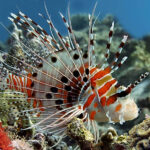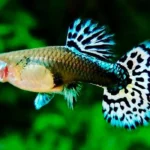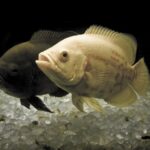The Paradox of Beauty and Danger
Lionfish (genus Pterois) are some of the most enchanting creatures within the ocean—long fins, bold stripes, and a grace that appears too best for predators.
However in the back of that distinguished beauty lies a robust risk—venomous spines, an aggressive urge for food, and a reputation for ecological destruction in non-local waters.
This article explores each aspect of this charming fish: its spellbinding look and its status as one of the sea’s maximum invasive threats.

Origins and Natural Habitat
Lionare native to the Indo-Pacific place, mainly the Purple Sea, Indian Ocean, and western Pacific.
In their native waters, lionfish populations are obviously managed by means of predators and environmental elements.
These fish thrive in warm, tropical waters and prefer coral reefs, rocky crevices, and lagoons.
They’re discovered at depths from 1 foot to over three hundred feet, relying on age and place.
The two maximum species:
The Aesthetic Appeal of Lionfish
Fish are regularly taken into consideration residing art—nature’s aquatic masterpieces.
Their look includes:
Vertical zebra-like red, white, and brown stripes.
Fan-like pectoral fins that ripple like silk inside the contemporary.
Needle-like dorsal spines that protrude like a crown or halo.
Many aquarists are interested in lionfish because of their otherworldly appearance and graceful motion.
Their stylish, soaring, sluggish, and deliberate swimming leads them to appear like aristocrats of the reef.
This splendour belies their danger—it’s the conventional “don’t contact me” camouflage.
Venomous Defenses: A Sting You’ll Never Forget
Fish are ready with 18 venomous spines:
13 dorsal
2 pelvic
three anal
These spines supply neuromuscular venom, inflicting:
excessive pain
Swelling
Vomiting
respiratory difficulties
In rare instances, brief paralysis or coronary heart complications
Even as hardly ever deadly to humans, the edge is excruciating and unforgettable.
Lionfish venom isn’t used to hunt but for self-protection, mainly against large predators.
Venomous—not poisonous: they’re safe to eat after cautious practise, seeing that venom is within the spines, not the flesh.
Behavior and Hunting Techniques
Lionfish are ambush predators with a specialized hunting style:
They nook prey the usage of their massive, fan-like pectoral fins.
Then they strike with lightning pace, swallowing prey complete.
Their diet includes over 70 special species of fish, invertebrates, or even juvenile groupers and snappers.
They may be commonly solitary but may additionally hunt in groups at some stage in feeding frenzies.
Lionfish are nocturnal but can also hunt all through the day, in particular when food is considerable.
Their stomachs can extend to 30 times their normal size, allowing binge-like feeding conduct.

The Invasive Crisis in the Atlantic and Caribbean
Lionfish were first documented off the coast of Florida in the mid-1980s.
It’s believed they had been released from non-public aquariums—in all likelihood, at some point during Typhoon Andrew in 1992.
Since then, lionfish populations have exploded along the East Coast, the Gulf of Mexico, and at some point of the Caribbean.
Do they have any natural predators in these waters?
One girl can lay 30,000 eggs each four days—over 2 million a year.
Eggs are free-floating and protected through a mucous layer, making them hard for other fish to consume.
Juvenile survival quotes are excessive in the Atlantic—a long way higher than those of their native variety.
Devastating Impact on Native Marine Life
Species impacted include:
Parrotfish (important for algae control on reefs)
Juvenile snappers and groupers (key commercial species)
Shrimp, crabs, and small reef dwellers
This results in:
Degraded coral health (due to algae overgrowth)
Economic harm to fisheries and tourism
Loss of biodiversity and ecosystem collapse in some regions
Why Aren’t They Getting Eaten?
In the Atlantic, native predators don’t recognize lionfish as food.
Their intimidating fins and venomous spines act as strong deterrents.
Few species—like large groupers, eels, and some sharks—may attempt to eat lionfish, but this behavior is rare and often only occurs after training in captivity.
Human intervention is the main “predator” attempting to curb their spread.
Human Efforts to Control Lionfish Populations
Governments, nonprofits, and divers have mobilized to control lionfish through:
Lion derbies and removal events
Spear-fishing campaigns
Training native predators in captivity
Promoting lionfish as food in local cuisine
Culinary use is an emerging trend:
Fish meat is white, flaky, and delicious, comparable to snapper or grouper.
Encouraging commercial demand could create economic incentives for control.
However, efforts only scratch the surface—eradication is likely impossible, but mitigation is essential.

The Lion in Aquariums: Beauty in Captivity
Aquarists must be cautious:
Secure tanks
Proper feeding (they often won’t eat flakes or pellets)
Understanding venom risk
They are best housed alone or with large, non-edible tank mates.
Misidentification of smaller species can lead to unexpected predation in tanks.
Despite being high-maintenance, lionfish captivate aquarium enthusiasts.
Scientific Studies and Genetic Curiosity
Researchers study lionfish genetics to:
Understand rapid adaptation in new environments.
Analyse venom composition for potential medical uses (painkillers, neurological treatments).
Genomic studies have revealed
High genetic diversity in the Atlantic invasion—suggesting multiple release events.
Rapid evolution in areas like thermal tolerance and salinity resilience.
Venom components show promise in pharmaceuticals, but extraction remains risky and complex.
Cultural Symbolism and Public Fascination
Lionfish have entered pop culture and folklore:
Symbolize beauty with danger
Featured in documentaries, art, and marine conservation campaigns
In some regions, lionfish jewellery made from fins and spines raises awareness and funds for conservation.
They’ve become mascots for invasive species education programs, illustrating how beauty can deceive.
Diving with Lionfish: Awe and Caution
They typically do not attack unprovoked, but
Accidental contact can cause painful stings.
Divers must stay aware, especially in tight coral areas.
Underwater photographers love lionfish for their elegance and visibility.
Some divers specialize in lionfish removal, using specially designed spears and containers.

Conclusion
In its natural Indo-Pacific home, the lionfish fits perfectly into the environmental jigsaw. But in the Atlantic and Caribbean, it’s an unwanted guest—one that consumes biodiversity, threatens native species, and reduces reefs to quiet ruin.
Human beings played a role in its development, and nowadays we bear the responsibility of dealing with its proliferation through identification, training, elimination attempts, or even cuisine.
The lionfish teaches us that beauty has to be handled with wisdom, and that in our increasingly globalised world, one tiny alternative—a planned or an unplanned one—may have some distance-achieving ripple effects. We can also never fully remove the lionfish from occupied waters, but through cooperation, ingenuity, and respect for ocean ways of life, we will discover a new equilibrium. The lionfish is more than just a fish—it is a lesson in watchfulness, version, and the fragrant dance of existence beneath the waves—and it’s considerably lovely at the very same time.
FAQs
Why are lionfish considered invasive in the Atlantic and Caribbean?
Fish are not native to the Atlantic or Caribbean. They reproduce rapidly and consume a large number of native reef fish because they lack natural predators in these areas, causing severe ecological damage to coral reef ecosystems.
How did lionfish get into Atlantic waters?
Lionfish are thought to have been brought into the world through the aquarium trade, with some being accidentally or intentionally released during storms like Hurricane Andrew in the early 1990s. Then, their population grew rapidly.
What do lionfish eat?
Lionfish are carnivorous and have a voracious appetite. They eat small fish, crustaceans, shrimp, and juvenile reef species, sometimes consuming prey up to half their size.
Do lionfish have any predators?
Large predators like groupers, sharks, and moray eels may occasionally consume them in their native Indo-Pacific range. In the Atlantic, predators typically avoid lionfish due to their venomous spines, though some trained or bold individuals have started preying on them.










